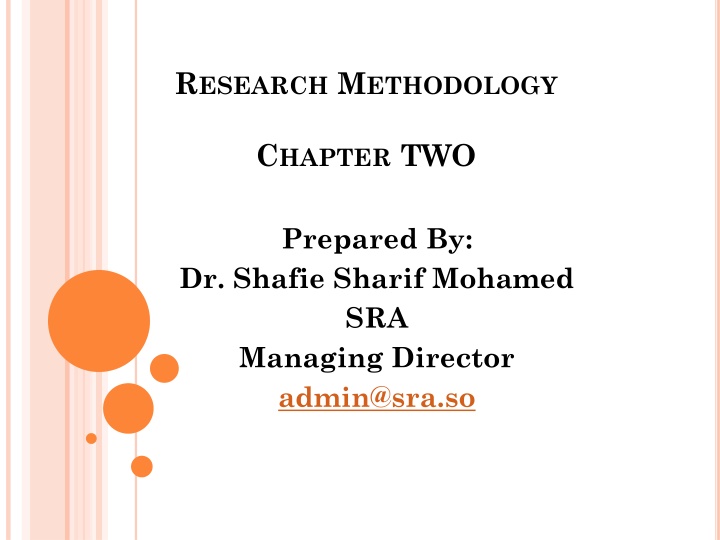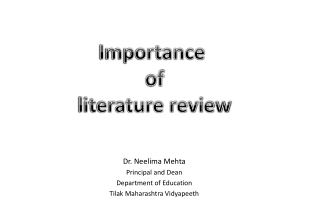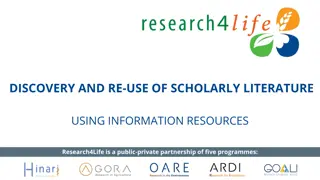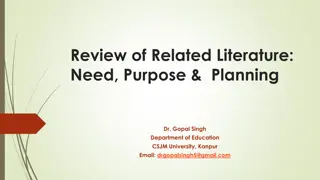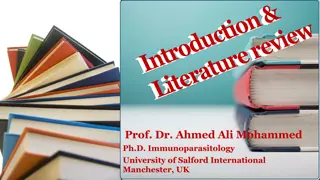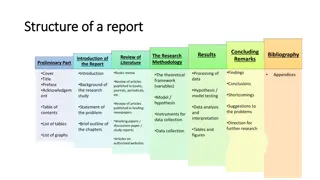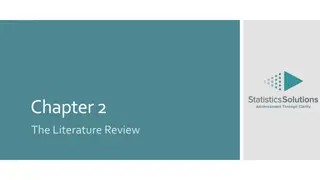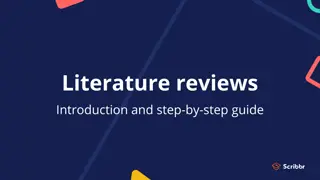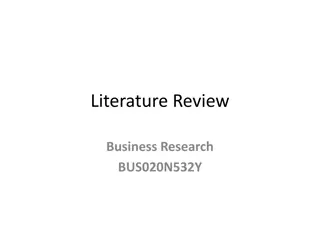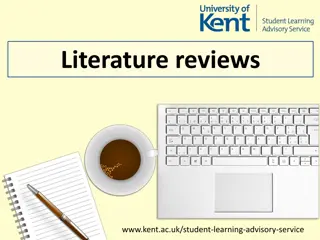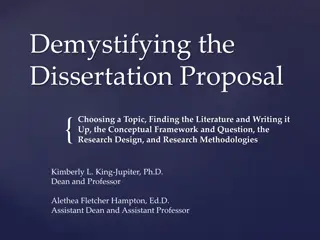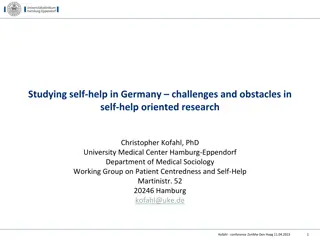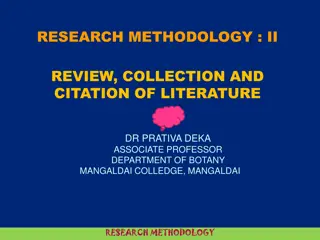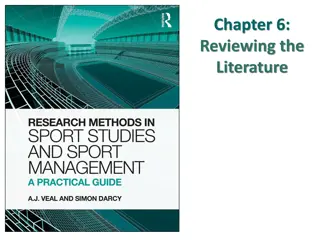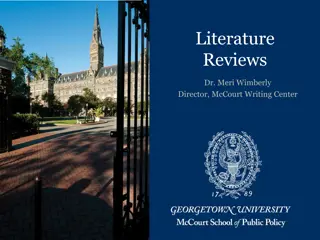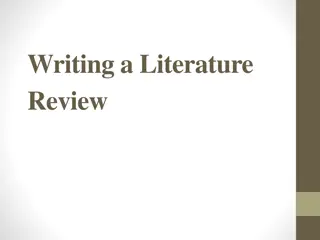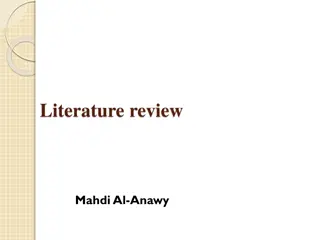Effective Strategies for Conducting a Literature Review in Research Methodology
Understanding the importance of literature review in research methodology, this chapter discusses the objectives, aims, and guidelines for writing a comprehensive literature review. It emphasizes the significance of identifying gaps in existing knowledge, structuring the review, and organizing information about variables. Essential tips are provided on choosing a topical, chronological, or problem-cause-solution order for organizing the literature review effectively.
Download Presentation

Please find below an Image/Link to download the presentation.
The content on the website is provided AS IS for your information and personal use only. It may not be sold, licensed, or shared on other websites without obtaining consent from the author.If you encounter any issues during the download, it is possible that the publisher has removed the file from their server.
You are allowed to download the files provided on this website for personal or commercial use, subject to the condition that they are used lawfully. All files are the property of their respective owners.
The content on the website is provided AS IS for your information and personal use only. It may not be sold, licensed, or shared on other websites without obtaining consent from the author.
E N D
Presentation Transcript
RESEARCH METHODOLOGY CHAPTER TWO Prepared By: Dr. Shafie Sharif Mohamed SRA Managing Director admin@sra.so
OBJECTIVES OF A LITERATURE Without literature review you don t understand your topic. You may not know what has already been done on it, how it has been researched and what are the key issues? Once you have established a gap within the literature, you are then able to argue what is unique about your research or what sort of contribution your research will make.
AIMS OF THE LITERATURE REVIEW FOR THESIS WRITERS Helps avoid unintentional replication of another study Identifies gaps in current knowledge Establishes the need for your research Helps define focus and boundaries of your research Explains your choice of theoretical framework and methodology Provides a well-argued account that supports your research question
GENERAL GUIDELINES TO WRITING A LITERATURE REVIEW Don t attempt to cover everything written on your topic You will need to pick out the research most relevant to the topic you are studying You will use the studies in your literature review as evidence that your research question is an important one
INFORMATION ABOUT VARIABLES It is important to cover research relevant to all the variables being studied. Research that explains the relationship between these variables is a top priority. You will need to plan how you will structure your literature review and write from this plan.
ORGANIZING YOUR LITERATURE REVIEW Topical Order organize by main topics or issues; emphasize the relationship of the issues to the main problem Chronological Order organize the literature by the dates the research was published Problem-Cause-Solution Order Organize the review so that it moves from the problem to the solution
LITERATURE TOPICAL ORDERORGANIZE 2.4 Background of the Somali Education Sector 2.4.1 Quranic Schools 2.4.2 Lower Primary and Intermediate Schools 2.4.3 Secondary Schools 2.4.4 Somali National University 2.5 War Effect on Somali Education 2.6 Reopening the Higher Education Sector in Somalia 2.7 Ministries of Education: North and North East Zones 2.8 Profile of Somali Universities in the Three Zones 2.9 Issues and Challenges Face Somali Universities 2.9.1 Universities Teaching Facilities 2.9.2 University Academicians 2.9.3 Universities Admission Process 2.9.4 Universities External Partners 2.9.5 Chapter Summary
REASONS FOR REFERRING TO PAST RESEARCH 1) Always note if the study was qualitative or quant. 2) Note if study is experimental or non-experimental 3) If an experiment, how were subjects assigned to test conditions? 4) Cause-and-effect vs. correlation 5) Reliability 6) Validity 7) Sampling, demographics, statistical significance
SOURCE OF LITERATURE Questions such as how much of previous research literature need to be reviewed? , How do I refer to the materials? and where do I find reference materials? are often asked before a researcher conducts his study. Actually, there is no limited to the number of reference materials that can be used. It is more important to refer to as much and as detail literature as possible which is related to the phenomenon one intends to study. Find reference materials at online libraries or academic journals. Familiarize yourself academic journals in your field. https://doaj.org/?fbclid=IwAR36SmUK0rO6Nbw7m_cIsnsRcXznYB EW4cfPIRIM7VBCNTHdxWOYy52RNME
WRITE AS YOU READ Do NOT just take notes WRITE AS YOU READ. This cuts down on 90% of your workload. CITE AS YOU GO! back to examine a source. You will not have to go You can either maintain separate sections for EACH author OR you can create sections that deal with similar information within those sections. ideas and place the
PARAPHRASING Paraphrasing is saying something someone else has said in your own words. You still express the same ideas, just in a different way. It can be a useful skill to have, especially if you are trying to write an essay or article.
Original: Giraffes like leaves and hay and they can consume 75 pounds of food a day. Paraphrase: A giraffe can eat up to 75 pounds of leaves and hay everyday.
EXAMPLEOF WRITING LITERATURE The reported benefits of postgraduate peer support networks According to Hope (2001) there are many benefits to distance students belonging to a peer support group Curry (2008) discusses the benefits for universities in having their students in peer support groups According to Apple (2006) not all distance students benefit from being members of a peer support group Woollen (2008) postgraduate students benefit from being part of a peer support network. Start with an overall idea or topic sentence, discussion or example using Study A and Study C,
WRITING THE LITERATURE REVIEW The research sample consists of 273 undergraduates randomly selected from five private colleges in KL (population size = 998) . They are divided into two separate subsamples, that is, 125 students who specialized in chemistry (80 males and 45 females) and 148 students who specialize in physics (75 males and 73 females)
EXAMPLE ( REPORTOFRESEARCHDESIGN ) this is an experimental study which uses a 2x2x2 factorial design. The factors are levels of intelligence (high, low), types of personality (introvert, extrovert) and cognitive styles (dependent, independent). The first group of respondents receive mathematical calculation skills training and the second group receive mental arithmetic skills training. Both groups went through the pre-test and post-test at a six-month interval.
EXAMPLE (REPORTONRESEARCHDATAANALYSIS) The result of the t-test analysis showed that the mean score of the science stream students exceeds the mean score of the arts stream students in all the five components of creative thinking skills. Thus, this researcher concludes that the science stream students have a higher level of critical skills compared to students in the arts stream.
EXAMPLE ( REPORTONRESEARCHRESULT) The research findings of Dunn (1989) showed that there is a difference in the mean score of eating a balanced meal between the group of males (M= 33.2, SD = 2.01; female: M=26.2, SD = 2.13)
WRITINGCRITICALREPORT (STRENGTHS & WEAKNESSES the explanation of Ruth and Birren (1995) was accurate in the 1980s. However, these days, the opportunity for education among the younger generation has changed. If this research were to be conducted today, its result be different because both genders now have equal opportunities to further their studies. (chua, 2002b, p. 168)
ADVANTAGES This way of paraphrasing has a few advantages: 1) Since I cite as I go, ALL of my citations are complete as I write the paper; 2) I have the ENTIRE article paraphrased; 3) I can choose which information to include and which to exclude; 4) I can cut and paste ANY piece of information to any section I want; 5) By the time I bring the paper together, 90% of it is ALREADY written. All I have left to do is organize the information, create transitions and explanations where necessary, and write the Introduction and Conclusion;
MINIMUMINFORMATION Regardless of whether you choose to paraphrase as you go OR NOT, you will need at a minimum: 1) The FULL bibliographic/Reference page/Works Cited page citation; 2) The methodology; 3) The major findings; 4) Weaknesses and strengths
CITINGLITERATUREINTHEBODYOFYOURESSAY: When the source has a single author: Haig (1993) explores the genetic conflicts between When the source has two authors: Hedrick and Duffield (1986) compare the blood When the source has three or more authors: Hurst et al . (1996) consider examples of selfish genes . * Note that et al. is a Latin abbreviation for "and others" and must be italicized.
When two sources are used in a single sentence: Both Haig (1993) and Hurst et al. (1996) discuss the .. Citing personal communications: Salmon embryos develop faster at higher temperatures (L. Albright, personal communication). Internet communications: Include the author and title of the website, its address and the date that you accessed it. If the paper is cited in one of your references: Hickey and Rose (1988, cited in Hurst et al., 1996) have proposed that .
BIBLIOGRAPHY Abukari, A., & Corner, T. (2010). Delivering Higher Education to Meet Local Needs in a Developing Context: the Quality Dilemmas? Quality Assurance in Education, 18(3), 191-208. Abdullah, F. (2006). Measuring Service Quality in Higher Education: HEdPERF Versus SERVPERF. Marketing Intelligence & Planning, 24(1), 31-47. Abdulle, J. (2009).Dare to Dream: Future of Somalia through the eyes of Students. Retrieved From Hiran Website. http://www.hiiraan.com/news4/2009/Oct/12478/soma li.
COMMON ERRORS MADE Review isn t logically organized Review doesn t relate literature to the study Too few references or outdated references cited Review isn t written in author s own words Review reads like a series of disjointed summaries Review doesn t argue a point More than one idea is introduced and developed
MANAGING NUMEROUS DEFINITIONS Very often, you will encounter the same concept defined in different ways by different researchers. This is especially important in research as how we define something determines how we can measure it. Consider building tables for definitions so as to keep track. The following is adapted from Galvan s (2006) book Writing Literature Reviews, Third Edition (pp. 63- 64):
CONCEPTUAL FRAMEWORK: The conceptual framework serves as a map that will guide you towards realizing the objectives or intent of your study. the conceptual framework is the researcher s understanding of how the particular variables in his study connect with each other. The first step in scientifically demonstrating a cause-effect relationship is to map your expectations using a conceptual framework. Before doing so, it s important to identify the relevant variables.
EXAMPLEOFACAUSE-EFFECTRELATIONSHIP Ben, a student, gets a perfect 100% on the big exam, which surprises his classmates. However, Ben has a very good explanation: he studied for many hours (the cause) and therefore scored well (the result). A cause-effect relationship always involves two types of variables: independent and dependent. In our example, hours of study is the independent variable, while examscore is the dependent variable. In other words, examscore depends on hours of study.
Literature Review After reviewing the literature, summarize what has been done, what has not been done, and what needs to be done Remember you are arguing your point of why your study is important! Then pose a formal research question or state a hypothesis be sure this is clearly linked to your literature review
VISIT Somali Researchers Association Website WWW.SRA.SO
